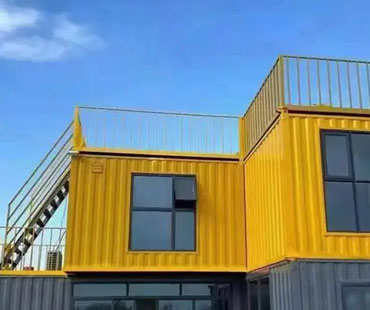In today’s fast-paced logistics and warehousing industry, maximizing space efficiency has become a critical goal for businesses across the globe. As companies strive to reduce operational costs and optimize storage capacity,collapsible containers have emerged as a practical and innovative solution. Designed for versatility, durability, and convenience, these containers offer significant advantages for businesses managing complex supply chains, seasonal inventory fluctuations, or limited warehouse space.
1. Understanding Collapsible Containers
A collapsible container, sometimes referred to as a foldable or stackable container, is a storage unit engineered to fold or collapse when not in use. Unlike traditional rigid containers that maintain their full dimensions at all times, collapsible containers can reduce their volume by 50–75% when empty, enabling easier storage and transportation.
These containers are commonly constructed from durable materials such as steel, aluminum, or high-strength polymer composites, allowing them to maintain structural integrity while being lightweight and portable. They are available in various sizes and configurations to accommodate different types of cargo, from bulk goods to delicate products.
2. Space Optimization: The Core Advantage
a. Maximizing Warehouse Capacity
Warehouse space is one of the most significant operational costs for logistics companies. Collapsible containers provide a straightforward solution by reducing the footprint of empty containers, freeing up valuable storage space for other goods. For example, a set of standard 40-foot collapsible containers can occupy as little as one-third of the space when collapsed, allowing warehouses to accommodate more inventory without additional real estate investment.
b. Enhancing Transportation Efficiency
Empty containers often need to be transported back to suppliers or ports for reuse. Traditional containers occupy the same volume whether full or empty, leading to inefficient transportation. Collapsible containers, on the other hand, stack compactly during return trips, reducing the number of truckloads or shipping containers required, lowering fuel costs, and minimizing carbon emissions.
3. Cost-Effectiveness and Operational Savings
Investing in collapsible containers can generate both immediate and long-term cost benefits:
Reduced Storage Costs: By occupying less warehouse space when not in use, businesses can optimize real estate usage and potentially avoid additional storage rental fees.
Lower Transportation Costs: Fewer trips are needed to move empty containers, cutting down on fuel consumption and labor expenses.
Durability and Longevity: High-quality collapsible containers are built to withstand repeated folding and unfolding without structural damage, ensuring a long service life and reducing replacement frequency.
Flexible Inventory Management: Companies can quickly scale storage solutions up or down based on seasonal demands without large capital investment in new containers.
These advantages make collapsible containers an attractive option for industries where cost control and operational efficiency are paramount.

4. Versatility Across Industries
Collapsible containers are not limited to one specific application. Their versatility allows them to serve multiple industries and purposes:
a. Logistics and Freight
Transportation companies can use collapsible containers to optimize backhaul trips, improving load efficiency and reducing deadweight shipping costs. This is particularly beneficial in international trade where empty containers frequently return to origin ports.
b. Manufacturing and Industrial Storage
Factories often require temporary storage solutions for raw materials, parts, or finished products. Collapsible containers enable quick reconfiguration of storage layouts and reduce clutter on production floors.
c. Retail and E-Commerce
Retailers and e-commerce fulfillment centers frequently deal with fluctuating inventory levels. Collapsible containers make seasonal or promotional stock storage easier, allowing facilities to adapt to changing product volumes without permanent space commitments.
d. Agriculture and Food Industry
Produce and perishable goods benefit from collapsible containers designed for airflow and easy handling. Farmers and distributors can store and transport crops efficiently while minimizing the risk of spoilage.
5. Sustainability and Environmental Benefits
Environmental considerations are increasingly influencing logistics decisions. Collapsible containers contribute to sustainability in several ways:
Reduced Carbon Footprint: By optimizing empty container transportation and warehouse space, fewer trucks and shipments are needed, lowering greenhouse gas emissions.
Material Efficiency: Many collapsible containers are constructed from recyclable metals or plastics, which can be reused or repurposed at the end of their lifecycle.
Waste Reduction: By extending the lifespan of storage solutions and reducing the need for additional containers, businesses contribute to a circular economy.
Companies adopting collapsible containers align with global sustainability goals while simultaneously improving operational efficiency.
6. Practical Considerations for Implementation
While collapsible containers offer numerous advantages, proper planning is crucial to maximize their benefits:
Material Selection: Choose containers made of robust materials that can withstand repeated folding and heavy loads without compromising safety.
Size and Compatibility: Ensure the containers are compatible with existing storage racks, forklifts, and shipping systems.
Handling Protocols: Train staff on correct folding and unfolding techniques to prevent damage and maintain safety standards.
Integration with Logistics Software: For large-scale operations, track container usage, location, and status using warehouse management systems to streamline workflows.
By carefully considering these factors, businesses can seamlessly integrate collapsible containers into their existing operations.
7. Future Trends in Collapsible Container Usage
As global supply chains become more complex and space becomes increasingly valuable, collapsible containers are likely to see expanded adoption:
Smart Containers: Integration of IoT sensors to monitor location, temperature, and load status in real-time.
Modular Designs: Interchangeable panels and adaptable dimensions to accommodate diverse cargo types.
Lightweight Composites: New materials reduce container weight while maintaining strength, further improving transportation efficiency.
Collaborative Sharing: Logistics networks may share collapsible containers between companies, optimizing utilization and reducing costs.
These trends point to a future where collapsible containers are not only space-efficient but also smarter, more adaptable, and integral to sustainable logistics.
In an era where operational efficiency, cost reduction, and sustainability are key business priorities,collapsible containers offer a compelling solution. By maximizing warehouse space, optimizing transportation, reducing costs, and supporting versatile applications across industries, they provide both practical and strategic advantages. Additionally, their environmental benefits align with modern sustainability goals, making them a forward-thinking choice for businesses aiming to streamline storage and enhance logistics operations.
As companies continue to seek innovative ways to improve supply chain efficiency, collapsible containers will remain a critical asset, transforming how goods are stored, transported, and managed across industries.


